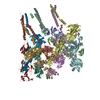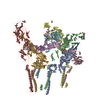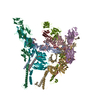[English] 日本語
 Yorodumi
Yorodumi- PDB-8sqn: CryoEM structure of Western equine encephalitis virus VLP in comp... -
+ Open data
Open data
- Basic information
Basic information
| Entry | Database: PDB / ID: 8sqn | |||||||||||||||||||||||||||||||||||||||
|---|---|---|---|---|---|---|---|---|---|---|---|---|---|---|---|---|---|---|---|---|---|---|---|---|---|---|---|---|---|---|---|---|---|---|---|---|---|---|---|---|
| Title | CryoEM structure of Western equine encephalitis virus VLP in complex with the chimeric Du-D1-Mo-D2 MXRA8 receptor | |||||||||||||||||||||||||||||||||||||||
 Components Components |
| |||||||||||||||||||||||||||||||||||||||
 Keywords Keywords | VIRAL PROTEIN/SIGNALING PROTEIN / WEEV / MXRA8 / Receptor / Alphavirus / Avian / VLP / Structural Genomics / PSI-2 / Protein Structure Initiative / Center for Structural Genomics of Infectious Diseases / CSGID / VIRAL PROTEIN-SIGNALING PROTEIN complex | |||||||||||||||||||||||||||||||||||||||
| Function / homology |  Function and homology information Function and homology informationT=4 icosahedral viral capsid / host cell cytoplasm / serine-type endopeptidase activity / fusion of virus membrane with host endosome membrane / symbiont entry into host cell / virion attachment to host cell / host cell nucleus / host cell plasma membrane / virion membrane / structural molecule activity ...T=4 icosahedral viral capsid / host cell cytoplasm / serine-type endopeptidase activity / fusion of virus membrane with host endosome membrane / symbiont entry into host cell / virion attachment to host cell / host cell nucleus / host cell plasma membrane / virion membrane / structural molecule activity / proteolysis / membrane Similarity search - Function | |||||||||||||||||||||||||||||||||||||||
| Biological species |   Western equine encephalitis virus Western equine encephalitis virus | |||||||||||||||||||||||||||||||||||||||
| Method | ELECTRON MICROSCOPY / single particle reconstruction / cryo EM / Resolution: 3.89 Å | |||||||||||||||||||||||||||||||||||||||
 Authors Authors | Zimmerman, M.I. / Fremont, D.H. / Center for Structural Genomics of Infectious Diseases (CSGID) / Center for Structural Biology of Infectious Diseases (CSBID) | |||||||||||||||||||||||||||||||||||||||
| Funding support |  United States, 1items United States, 1items
| |||||||||||||||||||||||||||||||||||||||
 Citation Citation |  Journal: Cell / Year: 2023 Journal: Cell / Year: 2023Title: Vertebrate-class-specific binding modes of the alphavirus receptor MXRA8. Authors: Ofer Zimmerman / Maxwell I Zimmerman / Saravanan Raju / Christopher A Nelson / John M Errico / Emily A Madden / Autumn C Holmes / Ahmed O Hassan / Laura A VanBlargan / Arthur S Kim / Lucas J ...Authors: Ofer Zimmerman / Maxwell I Zimmerman / Saravanan Raju / Christopher A Nelson / John M Errico / Emily A Madden / Autumn C Holmes / Ahmed O Hassan / Laura A VanBlargan / Arthur S Kim / Lucas J Adams / Katherine Basore / Bradley M Whitener / Sathvik Palakurty / Hannah G Davis-Adams / Chengqun Sun / Theron Gilliland / James T Earnest / Hongming Ma / Gregory D Ebel / Christian Zmasek / Richard H Scheuermann / William B Klimstra / Daved H Fremont / Michael S Diamond /  Abstract: MXRA8 is a receptor for chikungunya (CHIKV) and other arthritogenic alphaviruses with mammalian hosts. However, mammalian MXRA8 does not bind to alphaviruses that infect humans and have avian ...MXRA8 is a receptor for chikungunya (CHIKV) and other arthritogenic alphaviruses with mammalian hosts. However, mammalian MXRA8 does not bind to alphaviruses that infect humans and have avian reservoirs. Here, we show that avian, but not mammalian, MXRA8 can act as a receptor for Sindbis, western equine encephalitis (WEEV), and related alphaviruses with avian reservoirs. Structural analysis of duck MXRA8 complexed with WEEV reveals an inverted binding mode compared with mammalian MXRA8 bound to CHIKV. Whereas both domains of mammalian MXRA8 bind CHIKV E1 and E2, only domain 1 of avian MXRA8 engages WEEV E1, and no appreciable contacts are made with WEEV E2. Using these results, we generated a chimeric avian-mammalian MXRA8 decoy-receptor that neutralizes infection of multiple alphaviruses from distinct antigenic groups in vitro and in vivo. Thus, different alphaviruses can bind MXRA8 encoded by different vertebrate classes with distinct engagement modes, which enables development of broad-spectrum inhibitors. | |||||||||||||||||||||||||||||||||||||||
| History |
|
- Structure visualization
Structure visualization
| Structure viewer | Molecule:  Molmil Molmil Jmol/JSmol Jmol/JSmol |
|---|
- Downloads & links
Downloads & links
- Download
Download
| PDBx/mmCIF format |  8sqn.cif.gz 8sqn.cif.gz | 1.1 MB | Display |  PDBx/mmCIF format PDBx/mmCIF format |
|---|---|---|---|---|
| PDB format |  pdb8sqn.ent.gz pdb8sqn.ent.gz | 971.8 KB | Display |  PDB format PDB format |
| PDBx/mmJSON format |  8sqn.json.gz 8sqn.json.gz | Tree view |  PDBx/mmJSON format PDBx/mmJSON format | |
| Others |  Other downloads Other downloads |
-Validation report
| Summary document |  8sqn_validation.pdf.gz 8sqn_validation.pdf.gz | 1.6 MB | Display |  wwPDB validaton report wwPDB validaton report |
|---|---|---|---|---|
| Full document |  8sqn_full_validation.pdf.gz 8sqn_full_validation.pdf.gz | 1.6 MB | Display | |
| Data in XML |  8sqn_validation.xml.gz 8sqn_validation.xml.gz | 111.6 KB | Display | |
| Data in CIF |  8sqn_validation.cif.gz 8sqn_validation.cif.gz | 164.6 KB | Display | |
| Arichive directory |  https://data.pdbj.org/pub/pdb/validation_reports/sq/8sqn https://data.pdbj.org/pub/pdb/validation_reports/sq/8sqn ftp://data.pdbj.org/pub/pdb/validation_reports/sq/8sqn ftp://data.pdbj.org/pub/pdb/validation_reports/sq/8sqn | HTTPS FTP |
-Related structure data
| Related structure data |  40711MC  8danC  8daqC  8ewfC M: map data used to model this data C: citing same article ( |
|---|---|
| Similar structure data | Similarity search - Function & homology  F&H Search F&H Search |
- Links
Links
- Assembly
Assembly
| Deposited unit | 
|
|---|---|
| 1 |
|
- Components
Components
| #1: Protein | Mass: 30539.193 Da / Num. of mol.: 1 Source method: isolated from a genetically manipulated source Source: (gene. exp.)   Homo sapiens (human) Homo sapiens (human) | ||||||||
|---|---|---|---|---|---|---|---|---|---|
| #2: Protein | Mass: 47188.562 Da / Num. of mol.: 4 / Fragment: UNP residues 798-1235 Source method: isolated from a genetically manipulated source Source: (gene. exp.)  Western equine encephalitis virus / Production host: Western equine encephalitis virus / Production host:  Homo sapiens (human) / References: UniProt: Q1W679 Homo sapiens (human) / References: UniProt: Q1W679#3: Protein | Mass: 46171.617 Da / Num. of mol.: 4 / Fragment: UNP residues 321-735 Source method: isolated from a genetically manipulated source Source: (gene. exp.)  Western equine encephalitis virus / Production host: Western equine encephalitis virus / Production host:  Homo sapiens (human) / References: UniProt: Q1W679 Homo sapiens (human) / References: UniProt: Q1W679#4: Sugar | ChemComp-NAG / Has ligand of interest | Y | Has protein modification | Y | |
-Experimental details
-Experiment
| Experiment | Method: ELECTRON MICROSCOPY |
|---|---|
| EM experiment | Aggregation state: PARTICLE / 3D reconstruction method: single particle reconstruction |
- Sample preparation
Sample preparation
| Component | Name: Western equine encephalitis virus VLP in complex with a chimeric MXRA8 receptor (Avian D1 with Mammalian D2) Type: COMPLEX / Entity ID: #1-#3 / Source: MULTIPLE SOURCES |
|---|---|
| Molecular weight | Value: 7.45 MDa / Experimental value: NO |
| Source (natural) | Organism:  Western equine encephalitis virus Western equine encephalitis virus |
| Source (recombinant) | Organism:  Homo sapiens (human) Homo sapiens (human) |
| Buffer solution | pH: 8 |
| Specimen | Embedding applied: NO / Shadowing applied: NO / Staining applied: NO / Vitrification applied: YES |
| Vitrification | Cryogen name: ETHANE |
- Electron microscopy imaging
Electron microscopy imaging
| Microscopy | Model: TFS GLACIOS |
|---|---|
| Electron gun | Electron source:  FIELD EMISSION GUN / Accelerating voltage: 200 kV / Illumination mode: SPOT SCAN FIELD EMISSION GUN / Accelerating voltage: 200 kV / Illumination mode: SPOT SCAN |
| Electron lens | Mode: BRIGHT FIELD / Nominal defocus max: 2200 nm / Nominal defocus min: 500 nm |
| Image recording | Electron dose: 46.45 e/Å2 / Film or detector model: FEI FALCON IV (4k x 4k) |
- Processing
Processing
| Software | Name: PHENIX / Version: 1.20.1_4487: / Classification: refinement | ||||||||||||||||||||||||
|---|---|---|---|---|---|---|---|---|---|---|---|---|---|---|---|---|---|---|---|---|---|---|---|---|---|
| EM software |
| ||||||||||||||||||||||||
| CTF correction | Type: PHASE FLIPPING ONLY | ||||||||||||||||||||||||
| 3D reconstruction | Resolution: 3.89 Å / Resolution method: FSC 0.143 CUT-OFF / Num. of particles: 431316 / Symmetry type: POINT | ||||||||||||||||||||||||
| Refine LS restraints |
|
 Movie
Movie Controller
Controller





 PDBj
PDBj




